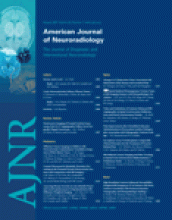We read with interest the article by Surendrababu et al1 about an unusual case of a solitary fibrous tumor (SFT) located at the atrium of the left lateral ventricle in an adult. Although rare, intraventricular SFTs have been described previously in the lateral ventricles, the third and fourth ventricles,2,3 where they certainly develop from the perivascular connective tissue of the choroid plexus. Preoperative diagnosis is challenging, because highly specific imaging features of SFTs have not been described. Surendrababu et al1 emphasize that SFTs are hyperintense on T2-weighted images. To the contrary, we think that they should have placed greater emphasis on the diagnostic value of SFT low T2 signal intensity. The lack of MR images in their case is troubling, because MR imaging may have demonstrated this important differential diagnostic feature. Indeed, low T2 signal intensity, corresponding with areas composed of interlacing bundles of spindle cells4 or collagenous septations,3 has frequently been reported in SFTs and is considered to be a suggestive feature of the diagnosis.3–5 We agree with the authors, however, that MR patterns of SFTs are variable, including T2 hyperintensity and/or cystic component, even when the mass is intraventricular.
To reinforce this idea, we illustrate the case of a 44-year-old woman with a multicystic SFT in the right lateral ventricle who presented with right retro-orbital pain and seizure. This multiloculated mass was hypointense on T1-weighted images, hyperintense on T2-weighted images, and demonstrated thin peripheral enhancement of multiple confluent cysts after gadolinium administration (Fig 1A). Histopathologic examination showed spindle cells, and immunohis-tochemistry was strongly positive for CD34, confirming the diagnosis of SFT (Fig 1B). The case described by Surendrababu et al1 and ours both emphasize the fact that intracranial SFT is an emerging entity that is diagnosed more frequently, especially in the cerebral ventricles. It is important to understand and recognize the protean nature and imaging polymorphism of this tumor.
A, Axial contrast-enhanced T1-weighted image shows a multiloculated cystic solitary fibrous tumor in the right lateral ventricle.
B, Histologic examination demonstrates marked anti-CD34 immunopositivity.
Acknowledgments
We are indebted to David Seidenwurm, MD, for his help in writing this letter.
- Copyright © American Society of Neuroradiology












